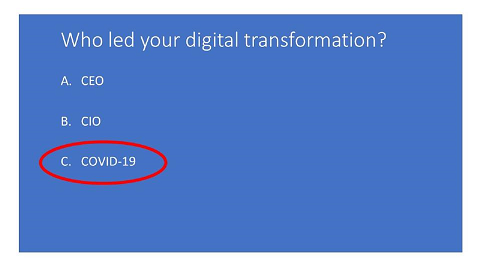Digital transformation – a phrase that’s not new in any respect, yet one that has received a new lease of life in this post-COVID world. The term digital transformation became popular in the 90s, had a resurgence in the mid-2000s, and is now one of the hottest topics in business today. While the phrase has remained the same, the definition on the other hand has evolved significantly over the years. What started as a need to ‘digitize’ workflows in the 90s, has grown into a movement to establish and nurture a true digital culture within the large majority of organizations.
That was before the pandemic.
An accelerated digital transformation
The rapid movement towards a socially distanced workplace as a result of COVID-19 has led to an acceleration of digital transformations in organizations, worldwide. Yet it may have also reverted the type of transformations that are occurring. Rather than focusing on building an information infrastructure that is robust yet agile and pairing that with a genuine culture that corroborates the uptake of digital – these hasty transformations are more closely aligned to those of the 1990s.

We have all probably seen versions of this image floating around the internet (this one is sourced from an article on Forbes). While it is intended as a ‘tongue in cheek’ reference to how organizations – while many have had the best intentions when it comes to digital transformation – have largely had their hand forced by the global pandemic.
Don’t get us wrong – a digital transformation of any ilk is valuable, and in many cases, critical for organizations to continue operating in the ‘new normal’. Yet, those that were enforced solely as a means of responding to the pandemic run the risk of being worryingly shortsighted. In a recent Gartner article, Sandy Shen, Senior Director Analyst said; “This is a wake-up call for organizations that have placed too much focus on daily operational needs at the expense of investing in digital business and long-term resilience. Businesses that can shift technology capacity and investments to digital platforms will mitigate the impact of the outbreak and keep their companies running smoothly now, and over the long term.”
Bearing in mind that this was quoted in early March when we were yet to truly realize the impact of the planetary lockdown, but the sentiment is still entirely valid. Yes, organizations need to respond quickly to the immediate impact of remote working, etc, but this can’t be at the cost of the ‘ultimate prize’, a digital transformation that lasts beyond tomorrow.
A digital transformation that lasts
So, what can organizations do to focus on a digital transformation that meets their immediate needs while ensuring it won’t cause a massive organizational headache in years to come? Well, one answer is to make information the center of your digital transformation. More specifically, building yourself an information infrastructure that is robust enough to meet your needs today, yet agile enough to respond to the challenges of tomorrow.
Consider the information you have within your organization that is critical to your day-to-day workflows. What about the external content that you rely on to keep you informed of global ongoing? The real-time financial data, critical in your decision-making? Internal datasets locked siloed away that could have saved you hours of additional research? The list is almost limitless, as is the size of the data pool we are referring to.
Now consider the pace at which information is increasing. Conservative estimates expect our global daily data-production to increase 100-fold by 2025. In an interview in i-Scoop with AIIM President, John Mancini defines this as “information and data chaos”. He then outlines the four core problems that this chaos causes in relation to a successful digital transformation as:
- How do we get any business insight out of the information we are collecting?
- How do we manage the risk of the growing volumes and complexity of content?
- How do we use information to better engage customers, employees, and partners?
- How do we automate our business processes?
These are the real considerations that must guide a digital transformation that lasts beyond tomorrow. Information is the heart of an organization and as such must play an integral role in building a long-lasting solution for the future.
These disruptive changes are often swept under the carpet or saved for a rainy day as the upheaval necessary to properly implement these are far too aggressive. The pandemic forced our hand. And, as this McKinsey article says, provides organizations a “mandate to be bold”.
Now that we’ve established the norms and built the necessary infrastructure to continue operating in the ‘new normal’, it is critical we take some time to consider the long-term, big-picture, plan of attack, etc, etc. It is of little value to do a half-hearted digital transformation, we’ve had to make the first step – let’s take the rest.

COMMENTS